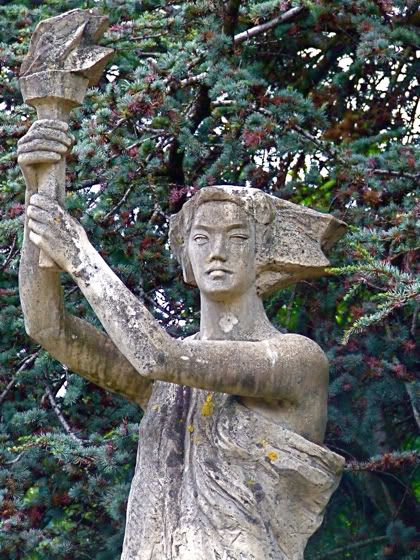
[A somewhat smaller version of Tsao Tsing-yuan's Goddess of Democracy lives on in the beautifully landscaped grounds of the University of British Columbia in Vancouver, having been erected there by that institution's Alma Mater Society; it was built in honour of the one which temporarily resided in Beijing's Tiananmen Square during the nascent pro-democracy movement which tried to emerge in China in 1989 and which Chinese officials brutally quashed, then spent the next twenty years attempting to expunge from the historical record. Similar replicas exist in Hong Kong's Victoria Park, in Portsmouth Square in San Francisco's Chinatown, on the grounds of the campus of York University in Toronto, at the University of Calgary, at Freedom Park in Arlington, and at the Victims of Communism Memorial in Washington, DC.]
1416 - The
Council of Constance, called by the Holy Roman Emperor
Sigismund - a supporter of Antipope
John XXIII - ordered
Jerome of Prague burned at the stake following his trial for heresy. Because that's what Jesus would have done.
1431 - 19-year-old
Joan of Arc was burned at the stake in
Rouen.
1434 - At the end of the
Hussite Wars, during the
Battle of Lipany,
Utraquist forces led by Diviš Bořek of Miletínek defeated and almost annihilated the
Taborite forces of
Prokop the Great. I have no idea what it means, but I just
loved typing it...
1536 - England's King
Henry VIII married
Jane Seymour, who had previously been a lady-in-waiting to his first two wives, the cast-off
Katherine of Aragon and the now-headless
Anne Boleyn.
1574 -
Henri III became King of France following the death of his brother
Charles IX.
1635 - Following the
Thirty Years' War the
Peace of Prague was signed.
1806 -
Andrew Jackson (the future 7th President of the United States) killed
Charles Dickinson in a duel after he'd accused Jackson's wife
Rachel Donelson Robards Jackson of
bigamy - an accusation which may, in fact, have been technically accurate. Dickinson was the only man Jackson ever managed to kill, despite his having taken part in 13 duels; he was himself hit in the ribs, but made a speedy recovery and, despite being 39 years old at the time, in fact lived another 40 years.
1814 - At the end of the
War of the Sixth Coalition the
Treaty of Paris was signed, returning French borders to their 1792 extent, where they were prior to the
Napoleonic Wars.
1854 - The
Kansas-Nebraska Act became law, establishing (oddly enough) the US territories of
Nebraska and
Kansas in addition to repealing the
Missouri Compromise of 1820.
1876 -
Abd-ul-Aziz, sultan of the Ottoman Empire, was deposed and succeeded by his nephew
Murat V.
1883 - A rumor that the
Brooklyn Bridge was about to collapse caused a stampede which led to the trampling deaths of twelve people.
1911 - At the
Indianapolis Motor Speedway, the first
Indianapolis 500 ended with
Ray Harroun in his
Marmon Wasp becoming the first winner of the 500-mile auto race.
1914 - The new and then-largest Cunard ocean liner
RMS Aquitania - displacing 45,647 tons - sailed on her maiden voyage from
Liverpool to New York City.
1922 - The
Lincoln Memorial was dedicated by former President and then-current Supreme Court Chief Justice
William Howard Taft.
1948 - A dike along the flooding
Columbia River in Oregon broke, obliterating the town of
Vanport within minutes; in all fifteen people died and tens of thousands were left homeless.
1953 - New Zealand's
Auckland Harbour Bridge was officially opened by Prime Minister
Sidney Holland, joining
Saint Marys Bay to
Northcote.
1971 - The
Mariner program's
Mariner 9 was launched to map 70% of the surface of Mars, and to study temporal changes in the atmosphere and surface of the planet.
1972 -
The Angry Brigade went on trial over a series of 25 bombings throughout Britain.
1989 - The 33-foot high Goddess of Democracy statue was unveiled in Beijing's Tiananmen Square by student demonstrators during a well-publicized series of pro-democracy protests there.
*
share on:
facebook


